Hashcat stands as the most powerful password recovery and cracking tool available for security professionals and penetration testers.
This quick guide covers essential Hashcat techniques for ethical password testing and recovery.
Getting Started with Hashcat
Download the latest version from hashcat.net.
Basic Requirements:
- GPU with OpenCL/CUDA support
- Updated GPU drivers
- Minimum 8GB RAM
- Hash file containing passwords to recover
- Wordlist for dictionary attacks
Common Attack Modes
| Mode | Description |
|---|---|
| 0 | Straight/Dictionary Attack |
| 1 | Combination Attack |
| 3 | Brute Force Attack |
| 6 | Hybrid Dictionary + Mask |
Basic Command Structure:
hashcat -m [hash type] -a [attack mode] [hash file] [wordlist]
Practical Examples:
hashcat -m 0 -a 0 hashes.txt wordlist.txt– Basic dictionary attackhashcat -m 1000 -a 3 hashes.txt ?a?a?a?a?a?a– Brute force NTLM hasheshashcat -m 0 -a 0 -r rules/best64.rule hashes.txt wordlist.txt– Dictionary attack with rules
Performance Tips:
- Use optimized wordlists like rockyou.txt
- Enable workspace cache with –weak-hash-threshold 0
- Monitor GPU temperature during long runs
- Use rule-based attacks before brute force
Common Hash Types:
- MD5: -m 0
- SHA1: -m 100
- NTLM: -m 1000
- bcrypt: -m 3200
- WPA/WPA2: -m 2500
Report bugs or issues on the official Hashcat GitHub repository.
Join the Hashcat community on hashcat forums for support and updates.
Safety Notes:
- Only test systems you own or have explicit permission to test
- Document all testing activities
- Keep recovered passwords confidential
- Follow local security testing regulations
Advanced Techniques
Custom Rule Creation
- Create custom rules in .rule files
- Combine multiple rules for complex mutations
- Test rules on small samples first
- Share effective rules with the community
Mask Attack Optimization
- Use custom charsets for targeted attacks
- Implement incrementing mask lengths
- Focus on common password patterns
- Optimize mask complexity for speed
Troubleshooting
Common Issues
- GPU driver compatibility problems
- Insufficient VRAM errors
- Hash format mismatches
- Performance degradation
Solutions
- Update OpenCL/CUDA drivers regularly
- Monitor resource usage with –status
- Verify hash formats with –identify
- Use –benchmark for performance testing
Conclusion
Hashcat remains essential for security testing and password recovery operations. Success depends on proper configuration, resource management, and ethical usage. Regular practice with different attack modes and continuous learning through community resources ensure optimal results.
Keep hash types documented, maintain updated wordlists, and follow security best practices. Professional password recovery requires patience, proper resource allocation, and responsible handling of sensitive data.
FAQs
- What is Hashcat and what is its primary purpose?
Hashcat is the world’s fastest password recovery tool that supports various hashing algorithms and attack modes. It’s used for cracking password hashes through different methods including dictionary attacks, brute force, and rule-based attacks. - Which operating systems support Hashcat?
Hashcat runs on Windows, Linux, and macOS. It supports both CPU-based and GPU-based password cracking, with GPU offering significantly faster performance. - What are the main attack modes available in Hashcat?
Hashcat offers several attack modes including Straight (dictionary attack), Combination, Brute-force, Hybrid, Association, and Rule-based attacks. Each mode is identified by a number (0 for Straight, 1 for Combination, etc.). - What hash types does Hashcat support?
Hashcat supports over 300 hash types including MD5, SHA1, SHA2, SHA3, NTLM, NetNTLMv1, NetNTLMv2, WPA/WPA2, and many others. Each hash type has a specific mode number for identification. - How can I optimize Hashcat’s performance?
Performance can be optimized by using powerful GPUs, implementing proper drivers, utilizing optimized rule sets, employing mask attacks when possible, and maintaining appropriate temperature control for hardware. - What’s the difference between hashcat and hashcat-legacy?
Hashcat-legacy is the CPU-based version that’s no longer maintained, while modern Hashcat combines both CPU and GPU capabilities with enhanced features and better performance. - What are potfiles in Hashcat and why are they important?
Potfiles store successfully cracked password hashes and their corresponding plaintext passwords, preventing Hashcat from re-cracking previously solved hashes in future sessions, saving time and resources. - How do I use rules in Hashcat for more effective password cracking?
Rules in Hashcat allow you to modify wordlist entries using functions like capitalization, number substitution, and character addition. Popular rule sets include best64.rule and rockyou-30000.rule. - What hardware specifications are recommended for running Hashcat effectively?
For optimal performance, modern GPUs with high CUDA cores or Stream Processors are recommended. NVIDIA GPUs like RTX 3080/3090 or AMD equivalents provide excellent performance. Adequate RAM and power supply are also crucial. - How can I determine the hash type if it’s unknown?
You can use tools like hash-identifier or hashid to identify the hash type, or compare the hash format with Hashcat’s example hashes (–example-hashes flag) to determine the correct mode.








